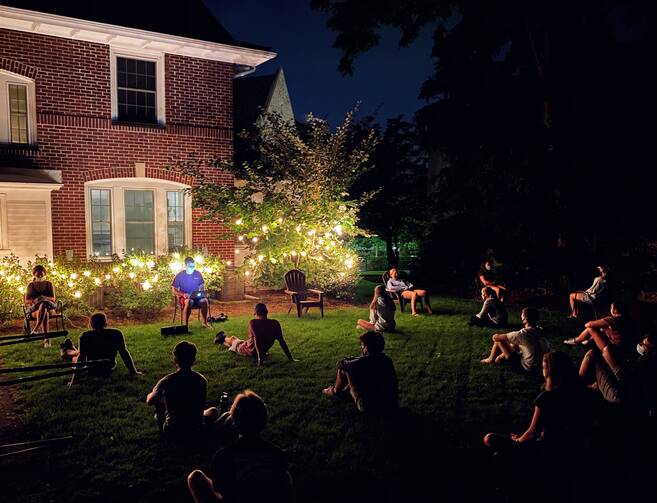“In a normal year, I would often meet students for coffee in my office or grab a meal,” Emily Egan, a campus minister at Boston College, told America. “Conversations were much more authentic when we could actually interact with students in person.”
Now, however, Ms. Egan finds herself meeting with students at odd hours. The spaces that used to be reserved for Boston College’s campus ministry have been repurposed as classrooms because of overflow resulting from new Covid-19 safety guidelines, and now most of her sessions with students are taking place virtually.
“Campus ministry is set up to be [a person-to-person] experience,” she said, but she is now communicating with students ahead of time to schedule online chats or helping them locate a private space in their noisy homes or finding ways to get around spotty internet access. Zoom, she explained, has been difficult.
“None of us have ever experienced anything like this before,” she said. “A lot of students are experiencing grief over losing their first year in college. The students who are here on campus are facing something very different from what they might have without the pandemic.”
Ms. Egan is just one of many campus ministers who have found themselves thrown off by the Covid-19 pandemic. When universities across the country were suddenly forced online by the pandemic, campus ministries were likewise forced to adapt to circumstances beyond their control.
At Fordham University, the associate director of campus ministry, Erin Hoffman, described how Fordham made the transition online in the spring. Weekly Masses were held over Zoom; large events that would have taken place in big auditoriums were recorded and released digitally to students; meditations were distributed as audio files; Ignatian yoga, long a cornerstone of Fordham’s campus ministry, was livestreamed to students so they could follow along at home.
“A lot of students are experiencing grief over losing their first year in college."
Despite that Covid-19 crash course in online learning in the spring, Ms. Hoffman had a lot of work to do over the summer to figure out how to handle things in the fall. “We started to think about how to foster community before the students got to Fordham,” she said. Particular emphasis was placed on incoming freshmen, who would be experiencing campus ministry for the first time.
The school had to think clearly about how to operate within a hybrid in-person and remote model. One major change involved making sure that the university’s regular retreats conformed to the university’s pandemic guidelines.
All students can now participate in retreats virtually. Small-group breakout sessions include students on video calls, and speeches from student leaders are streamed live over Zoom.
And life for students on campus has also changed; they are required to observe social distance rules and wear masks.
Ms. Hoffman expressed some concern that campus ministry, ideally an intimate and spiritually uplifting experience, might be compromised by all of the Covid-19 restrictions. Community is something students “thirst for every year,” Ms. Hoffman said, but perhaps never more so than after they have been forced to remain isolated for so long over the summer.
“The desire for a sense of community is very high, now more than ever,” Ms. Hoffman said.
At Boston College, Ms. Egan discovered that some methods for adapting to the pandemic worked better than others.
The school began to employ a “hybrid model” of ministry that “facilitated large gatherings by spreading small groups out into different locations across campus that all come together for a common Zoom speaker or shared reflection,” Ms. Egan explained. “This allows students who desire the in-person connection to do so in a safe, physically distant way while also allowing students who are virtual for the semester to fully participate.”
Ms. Egan emphasized that campus ministers should be “transparent and open with students about the ambiguity of planning during a global pandemic.”
She said that they were forced to “get creative” about building community, especially at school Masses. “Students who attend often get to know one another by gathering before or after Mass,” she said, emphasizing that this was particularly important for freshmen. “We’re inviting students to submit their names via a QR code if they’d like to be paired with another first-year student for an introductory outdoor walk.”
Ms. Egan herself continues to go on walks with her students, though physically distanced. “The majority of students I work with prefer meeting in person whenever possible,” she said.
Zoom has proved a barrier for a great many students, she said. “We had a daylong retreat for service immersion leaders in August using the hybrid model. While it went very well, I think attention span over Zoom is shorter than being together in person, so it’s helpful to accommodate for this when considering the length of programming.”
Most importantly, though, Ms. Egan emphasized that campus ministers should be “transparent and open with students about the ambiguity of planning during a global pandemic.” She suggests “inviting students to reflect about the ways in which such challenging uncertainty can lead to skill-building for self-care, increased self-knowledge, deeper community and rich faith exploration.”
Ken Weber, a university minister for Loyola University New Orleans, spoke to the unique avenues that a remote experience might offer.
“Most college students enjoy their experience in ministry throughout college because it’s connected to a community,” he said. “The big challenge was how to create a context for them to feel like they’re part of that community.
“The pandemic forced our hand. If we’re not present online, then we’re not present at all.”
“The idea is that students respond to students, so the more opportunities we have to [help] student leaders in ministry [engage with] their fellow students, the better the engagement metrics become,” Mr. Weber said. “The hunger for engagement remains constant, whether online or in person.”
He has been encouraged by greater numbers for some of the school’s flagship programs than in past years, even though those participants are online. Mr. Weber suspects some students who normally would not have participated are choosing to do so now “because they simply are seeking any kind of communal experience, religious or not, in response to the isolation of Covid.”
He attributes much of this success to Loyola New Orleans’ new strategy of pursuing students where they are. Most of their outreach used to take place outside of the digital realm. Now, their outreach involves extensive use of social media.
“We’re much more present [on social media] now than we ever were before, just out of necessity. The reach that’s possible through social media is exponentially greater than being in person or putting fliers on bulletin boards.”
“We were aware of these avenues before, but we never really used them,” he said. “The pandemic forced our hand. If we’re not present online, then we’re not present at all.” He explained that when students see that their friends are tagged on a post, it generates a sense of curiosity to explore campus ministry.
Mr. Weber described this new avenue of reaching students as a “silver lining” to the pandemic and called it integral to their new outreach strategy. Ultimately, though, he said that involvement in campus ministry is up to each student.
“Happily, the experiences of community that we offer in ministry provide opportunities for engagement directly with our Catholic, Jesuit mission,” Mr. Weber said. “So anyone seeking community that ends up engaging in one of our programs will receive what we hope for all of our students—an experience of Ignatian spirituality and Catholic cultural values.”









